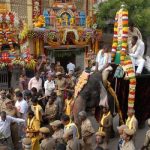Thousands of devotees attired as brides of Lord Shiva, participated in the religious rituals conducted at Sri Raja Rajeshwara Swamy temple in Vemulawada of Karimnagar district on the occasion of Sri Ramanavami celebrations on Sunday. The Sri Raja Rajeshwara Swamy devasthanam, popularly known as Dakshin Kashi, in Vemulawada is celebrates the celestial wedding of Lord Rama with his consort Sita on Srirama Navami.
Men, women, children and transgenders ‘marry’ Lord Shiva on this Sriramanavami day, a practice unique to the historic Vemulawada shrine, to seek fulfilment of their wishes and freedom from ailments.
The devotees dressed themselves as brides of Lord Shiva by wearing new clothes and bangles. As part of the marriage ritual, the devotees take a holy dip in ‘dharmagundam’ (holy tank), wear new clothes and apply turmeric and vermilion on their body and decorate themselves as brides of Lord Shiva by carrying His trident (trishul), which is also decorated with bright flowers and a bell. Devotees were given ‘rudraksha or lingam’, a necklace of beads, as ‘dharana’ by the local priests. Carrying a ‘jhola’, containing ‘thalambralu’ (rice mixed with turmeric), they witnessed the celestial wedding of Lord Rama with his consort Seeta at the temple.
The devotees frequently shook their ‘trishuls’ to make a rhythmic sound as the wedding was performed amid chanting of Vedic slokas. As soon as the ritual was over, they took out grains from their ‘jholas’ and threw it on the idols. Then, the priests also declared them married to Lord Shiva.

Temple priest Namilikonda Umesh Sharma said that the tradition of wearing ‘dharana’ (tying of rudraksha or lingam around the neck) continued at the temple from the time of Chalukya dynasty.
The Chalukyas were followers of Jainism and Shaivism, he said and added that the devotees coming as bride of Lord Shiva was also a tradition followed at that time. These devotees used to propagate the importance of Shaivism during the period and many do it for their well-being.
Must Read Andhra Pradesh : Dalits build their own Ram Temple









